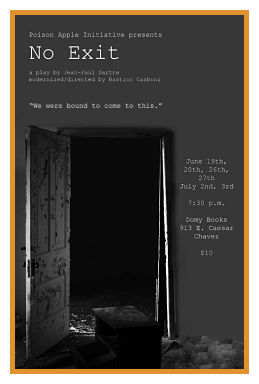Review: No Exit by Poison Apple Initiative
by Michael Meigs
With a sort of purposeful negligence, I have long avoided some of the leading French writers of the twentieth century. Existentialism enjoyed a vogue both in literature and in philosophy when I was at university, but I didn't care for its dour aspects. Mine was a deliberately uninformed prejudice, the sort that is likely to perpetuate itself comfortably for a lifetime.
Less than a decade after that, we lived for two difficult years in Oran, Algeria, the scene of Camus' novel La Peste (The Plague). Abandoned by the French at Algeria's 1960 independence, Oran was a hollow, dirty ghost of its former snug glory, increasingly well suited to Camus' nihilistic 1947 novel and no inspiration to visit the grim literature of 1940s France.
So I was not familiar with Sartre's No Exit, other than for its famous tag line, "L'enfer, c'est les autres" -- usually translated without grace as "Hell is other people." Given Sartre's ideas and the context of the play, a better version might be something along the lines of "Hell's greatest torture is having to deal with other individuals."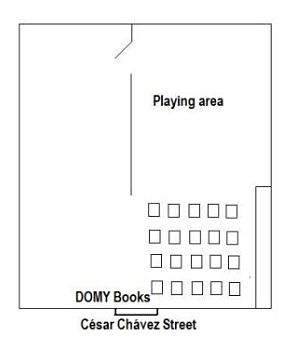
Bastion Carboni and the Poison Apple Initiative staged the play at DOMY books on east César Chávez Street. I was unexpectedly able to slip into one of the back rows for their final performance on July 3.
Half of the bookstore had been vacated, leaving a deep space with white walls, furnished only with three chairs and a bronze figure. It was a semi-improvised playing space, showing the company's ingenuity in delivering drama with a low overhead, in cooperation with a sponsor.
Without an elevated stage or risers for the seating, sightlines were terrible. From my rear row, I often could not see faces and I completely lost all of the business performed by actors when seated. One's ability to follow a story is often greatly compromised when one can't see what is going on, and that was my situation.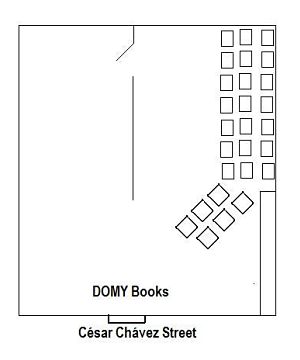
With an apology for Monday morning quarterbacking, let me mention my conviction that the playing space could have been organized for better comprehension.
The Poison Apple configuration gave those actors a deep playing space, appropriate for Sartre's concept and message, but the audience would have greatly benefited from an alternative seating plan, such as the one shown here. The cast and director would trade the distances of alienation for proximity and immediacy.
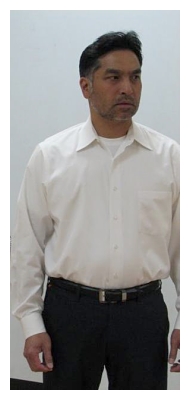
No Exit is a lengthy one-act piece for three actors. Initial scenes explain the concept. A clerk accompanies Joseph Garcín, former newspaperman, into this blank white space. From their conversation we realize that this is the afterlife. Garcín expects it to be hell and he is a bit creeped out not to find any torture instruments awaiting him. The clerk explains some of the rules (eternal illumination, no need for bodily functions, no program). Subsequently introduced into this white-noise afterlife are Inez, a postal clerk, and Estelle, a self-centered flirt. Garcín's initial attempts at cordiality and civility fail. The three wind up divulging their crimes in life and then testing themselves against one another. Sartre sets them relentlessly courting, excluding one another, witnessing and quarreling.
Rommel Sulit has a courtly gravity and baffled demeanor appropriate for Garcín. We learn that he was shot to death, probably by firing squad, and that he rues deeply his belated attempt to flee prosecution. Sartre's Garcín came from Río (presumably Río de Janiero, Brazil) but Poison Apple has him claim San Francisco as his domicile and work place.
As postal clerk Inez, a lesbian who broke up a marriage by seducing the wife, Jen Brown is direct and dismissive of Garcín, once she realizes that he is not a lurking torturer.
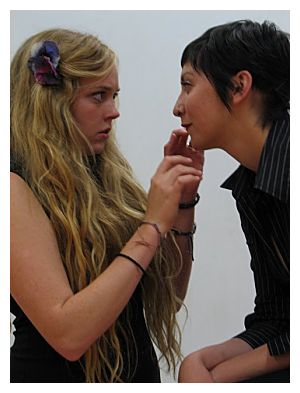 The third of the group, played by Helyn Rain Messenger, is the coquette Estelle, quite put out by the fact that there are no mirrors in the afterlife. Inez lusts after Estelle, and there's a charged scene in which Inez offers her own eyes and reactions to serve as Estelle's mirror.
The third of the group, played by Helyn Rain Messenger, is the coquette Estelle, quite put out by the fact that there are no mirrors in the afterlife. Inez lusts after Estelle, and there's a charged scene in which Inez offers her own eyes and reactions to serve as Estelle's mirror.
I followed with appreciation the changes that Sartre was systematically ringing on these three characters. Sulit was syllable-clear throughout, but I found repeatedly that I was missing the meaning of details recounted by both of the women. The obstructed sight lines were part of this, but I had the feeling that Rain Messenger and, to a lesser extent, Brown were not inflecting their texts sufficiently to establish beats of action. No one was missing lines, as far as I could tell, but except for the two-scene between the women, mentioned above, the texts were pushing ahead with an energy that sometimes outran the meaning.
Because of that I hit Half Price Books on the way home and snagged a volume of Sartre's plays. I wanted to make sure I got those individual histories right.
This piece was first performed in Paris in May, 1944. The French had been under German occupation for four years at that point, and the Allies had not yet landed in Normandy. Sartre had been in uniform only briefly. He had spent nine months as a prisoner of war before returning to Paris as a civilian and a high school teacher. After attempting to form a group of intellectuals to preserve French dignity before the Germans, he essentially gave up and devoted himself principally to writing. His tactic was similar to that of the German intellectuals faced with Hitler, who had resorted to an "inward migration" into abstract intellectual concerns rather than confrontation.
The German censor made no changes to No Exit. Even so, the picture of three sinners locked in a faceless hotel without obvious torture certainly bears resemblance to the plight of France at that moment. Garcín the pacifist agitator says he was apprehended "while taking the train to Mexico" -- an impossibility if traveling from Río de Janiero (per Sartre) and highly unlikely if traveling from San Francisco (per the Poison Apple Initiative). Sartre was writing for an imaginary world, but one with trains that ran just about everywhere, as in Europe.
Some point to the fact that Sartre and his consort Simone de Beauvoir were indulging in various threesomes about that time. Others assert that Sartre might have been giving a glimpse of purgatory rather than of hell. If one were inclined to credit him with intellectual daring-do under the noses of the Germans, that could include a vision of eventual liberation from this barren scene. I think Sartre was more of an old cuss than that, though, and he really did think that life was hell.
Whatever his opinion or motivation, No Exit gives you three sharply defined characters and entertains you by setting them at one another's throats. None is better than another, and no combination of two succeeds against the third. That triangle goes around and around.
The best line in the play is the last, once they have realized their predicament and collapsed in laughter over the fact that they're stuck together for eternity.
After a brief silence, Garcín says, "Well, well, let's get on with it. . . "
Thanks to Bastion Carboni and the cast for wising me up with this production. I'm looking forward to their future work.
EXTRA
Click for program of No Exit by the Poison Apple Initiative
Hits as of 2015 03 01: 1483
No Exit
by Jean-Paul Sartre
Poison Apple Initiative
Cesar Chavez
Austin, TX, 78702
